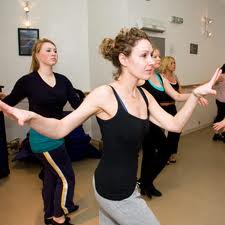See Active Blog For Zumba Workout Video
 Zumba is both a dance class and a fitness class. Aside from its heart-health benefits, Zumba provides a workout for the whole body. From head and shoulder rolls that loosen up the neck and warm up the upper body, to footwork that strengthens and stretches calves and ankles, this fitness method touches on nearly every muscle and joint. Even those who are just learning the dance steps will find themselves waking up the day after a Zumba class with a definitive post-workout feeling. Hips and abs receive particular attention in the Latin dance style, and as with many dance exercise classes, thighs and butts often end up being sore the day after class. Flexibility is not ignored in a Zumba class either,with warm-ups and cool-downs a regular part of Zumba programming.
Zumba is both a dance class and a fitness class. Aside from its heart-health benefits, Zumba provides a workout for the whole body. From head and shoulder rolls that loosen up the neck and warm up the upper body, to footwork that strengthens and stretches calves and ankles, this fitness method touches on nearly every muscle and joint. Even those who are just learning the dance steps will find themselves waking up the day after a Zumba class with a definitive post-workout feeling. Hips and abs receive particular attention in the Latin dance style, and as with many dance exercise classes, thighs and butts often end up being sore the day after class. Flexibility is not ignored in a Zumba class either,with warm-ups and cool-downs a regular part of Zumba programming.
Warm-up
Before participating in Zumba, perform a few warm-up exercises. From a standing position, take a deep breath and stretch your arms above your head. Breathe and stretch several times to get oxygen flowing throughout your body and to loosen up your back, shoulders and arms. To warm up and loosen your core, next perform standing hip circles for two to three minutes. Slightly bend your knees for easier movement and control. It’s not necessary to make hip circles dramatic to effectively warm up the core muscles. Get legs ready for Zumba by marching in place for a few minutes, and slowly add rhythm to marching by allowing your hips and upper body to move with the music beats. Gently but rhythmically march forward, backward and around in a circle to prepare for Zumba Latin dance moves. Warm up for approximately five minutes.
Salsa
From a standing position, take fairly large, alternating side steps to begin salsa dancing. Each time you step out to the side with one foot, shift your weight and  return it to a standing position for support so that you can side step with the other foot. Once you get the hang of the salsa side steps, begin stepping to a four count beat. Add body rhythm next by slightly moving your hips with each move. Hip and upper body movements should be natural and not cause strain. Practice hip movements separately by imagining your pelvis moving in a circular motion like they would if you were using a hula hoop, Then gently use the circular movement to help propel you with each salsa step. If you start to feel pain with hip and upper body movement, stick with foot movements only. Practice basic salsa steps for five minutes.
return it to a standing position for support so that you can side step with the other foot. Once you get the hang of the salsa side steps, begin stepping to a four count beat. Add body rhythm next by slightly moving your hips with each move. Hip and upper body movements should be natural and not cause strain. Practice hip movements separately by imagining your pelvis moving in a circular motion like they would if you were using a hula hoop, Then gently use the circular movement to help propel you with each salsa step. If you start to feel pain with hip and upper body movement, stick with foot movements only. Practice basic salsa steps for five minutes.
After you’ve leaned salsa side step moves, add back and forward salsa steps, basically the same way you would for side steps, but travel back and forth to the front and back. You can perform repetitive back steps or front steps, or you can continuously alternate between a back step and a front step. Add variety by traveling forward, backward or to the side with continuous salsa steps in one direction at a time. Mix it up with different salsa moves and perform the dance for about five to ten minutes during a 20-minute exercise workout.
See video for demonstration
Mambo Cha-cha
Combine mambo and cha-cha dance moves for a basic Zumba five-minute  routine. Basic mambo moves typically involve a pronounced step forward, backward or to the side with a weight shift. The cha-cha involves either moving steps or mambo steps in any direction with a quick three-step move in between. Perform cha-cha steps to a four count beat, according to BallroomDancers.com. Mambo cha-cha is frequently used in Zumba exercise workouts because it’s a more basic cha-cha dance. To perform it, mambo forward and backward and cha-cha step in between. Practice variations of mambo cha-cha for approximately five to ten minutes during a 20-minute exercise workout.
routine. Basic mambo moves typically involve a pronounced step forward, backward or to the side with a weight shift. The cha-cha involves either moving steps or mambo steps in any direction with a quick three-step move in between. Perform cha-cha steps to a four count beat, according to BallroomDancers.com. Mambo cha-cha is frequently used in Zumba exercise workouts because it’s a more basic cha-cha dance. To perform it, mambo forward and backward and cha-cha step in between. Practice variations of mambo cha-cha for approximately five to ten minutes during a 20-minute exercise workout.